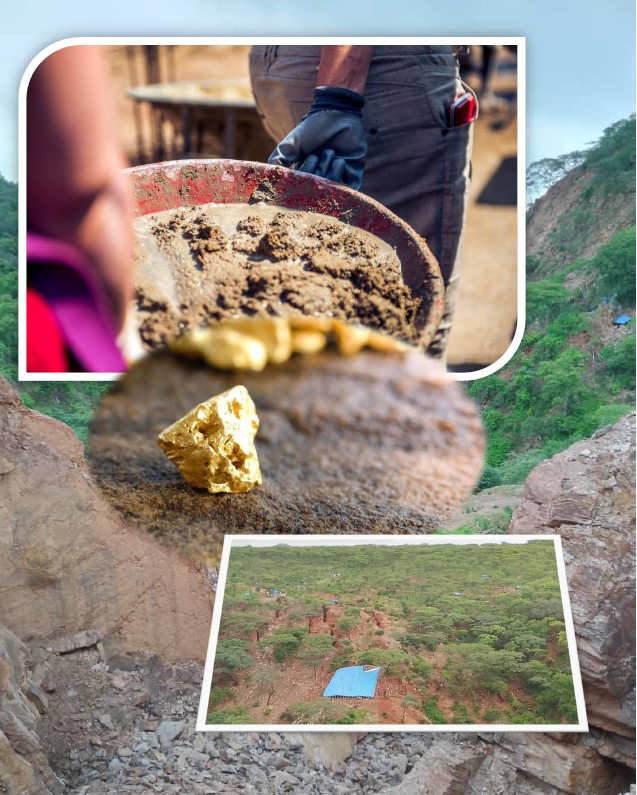By Chishaba Masengu & Charles Mafa
Despite the rugged and uneven road leading to Kabombo gold mine from Great East Road, hundreds of gold dealers continue to access the area in Rufunsa district.
Until 2013, Kabombo, an area next to Luano Valley was infamously known for the notorious Mailoni brothers, the serial killers, who terrorised locals and hindered development efforts in the entire area.
Following the death of the trio at the hands of the Zambia Army, the government pledged to bring development and civilisation to the region. However, this promise has yet to materialise fully.
Situated south of the Mkushi district and to the east of Kabwe town, the Kabombo and Luano areas are rich in gold, copper, zinc, silver, and other minerals.
Despite this potential, illegal artisanal miners have primarily exploited the abundant gold deposits, particularly in the areas of Chiefs Mbosha and Kanyensha of the Lala-speaking people.
Additionally, these miners operate in Chief Shikabeta’s area in Rufunsa, where a MakanDay journalist recently conducted an investigation. (See Part I | https://www.makanday.com/posts/zambias-gold-rush-chaos).
“Some individuals have left the comfort of their homes and families to reside here for months, tirelessly searching for gold deposits,” the guide, using the pseudonym Alfred Chola, explained.
Mr. Chola explained that these miners set up tents around the mining craters and crevices, forming part of a larger community of miners in makeshift market camps where processing and trading take place.
After what felt like an eternity of navigating bumpy terrain, punctuated by challenges like pit stops to fix a broken car bumper and seemingly endless negotiation for directions, the MakanDay journalist, accompanied by Mr. Chola, finally arrived at what appeared to be a broad expanse of blue tents.
This place is one of three market camps in the area, known as ‘baby market,’ with the neighbouring two referred to as the ‘new and old markets.
Returning to the makeshift miners’ compound, Mr. Chola brought along his colleague, Eric Ng’onga, in his forties, a local illegal artisanal miner. Mr. Ng’onga was eager to meet the MakanDay journalist, who had posed as an investor interested in investing in the artisanal mining business.
Apparently, Mr. Ng’onga was previously a gold miner in Mumbwa district but chose to relocate to Rufunsa.
He said he relocated to Luano because the gold in the area is much heavier and more valuable than what is found in other parts of Zambia.
“You have to invest K6,000 ($250 at the current exchange rate) to acquire dynamite from a Lusaka-based Chinese businessman specialising in quarry excavation mining, known as ’70-70′. While no one holds an authorised licence in Zambia to supply dynamite, ’70-70′ is the exception,” Mr. Ng’onga explained.
Located around the Zingalume area in Lusaka, his factory possesses a quarry excavation licence. However, authorities are unaware of his simultaneous gold mining operations in Zambia.
Mr. Ng’onga elaborated that the dynamite is essential for blasting unexplored sections of the gold mine, exposing mineral trails for exploration.
The tents, functioning as gold milling depots, host women pounding gold ore in traditional metal mortars, constituting part of the supply chain.
“Miners entrust the ore to these women after extracting it from the pit, preferring this method over milling machines provided by a company called Gold Hunters, which fail to grind the ore to fine silt. Consequently, some gold ore remains unrefined,” Mr. Chola explained.
MakanDay established that makeshift camp operates unauthorised milling bays and buyers’ market due to miners feeling exploited by gold buyer, who allegedly levy a 40% tax on each gold transaction with artisanal miners. Supposedly, part of this tax goes towards paying royalties to the chief.
Apparently, Gold Hunters, the licenced company within Kabombo’s mines, wield significant control over the gold trade.
Miners allege the company imposes a mandatory fixed price of K1,000 ($42) per gram, subject to a 40% tax, resulting in miners receiving K600 ($25) per transaction. Conversely, ‘illegal’ gold traders in the camp offer a better deal of K1,100 ($46) per gram without taxation.
Moreover, miners claim that the local chief, Chief Shikabeta receives payments of K1,000 ($42) monthly from ‘illegal’ market camp processing depots, in addition to a portion of the 40% milling tax from Gold Hunters on each gold processing transaction.
No response from Chief Shikabeta and the company
Both the company and Chief Shikabeta were unavailable to respond to these allegations. MakanDay reached out to both parties, but neither accepted the opportunity to respond.
At the depot, where the gold is extracted from ore, sieved gold ore is mixed with mercury, which condenses available gold particles. As the mercury-coated particles settle, the fire roasting process transform them into yellowish gold.
“After ten minutes, this tiny gold spec,” he said, placing it in the author’s palm, “is worth K500 ($21).” Mr. Ng’onga boasts of miners making substantial profits, recalling a day when he spent K5,000 ($208) on trivial expenses like alcohol and generosity toward friends.
“Even young boys here earn around K2,000 ($83) on a good day. They’re disinterested in schooling, believing they’ve already achieved success,” he remarked.
Without learning centres, camps lack educational opportunities, with the nearest school situated approximately 28 kilometres away. Some miners deem the distance unreasonable when they can earn within the mines.
An encounter with teen miners
Lameck Benzu, a teenager in his mid-teens, was spotted milling around the camp. When questioned why he is not interested in education, he simply chuckled and dismissed the question. Benzu appeared unwell, hence he was taking a rest and had refrained from mining on that day.
The camp may not have been sanctioned by government as a legal settlement, but what is surprising is the presence of government services through mobile health services and heavy police presence to provide security.
If these services are available then why has government not formalised the camp and provide artisanal miners with mining tools? This is what we asked the Ministry of Mines and Minerals Development for answers, but the Ministry is yet to respond.
The parting words of Mr. Chola, the guide, resonate: “You don’t need anything like a licence; all you have to do is go to the mining site with an experienced local traditional surveyor who will help you spot the gold deposit trail. The surveyor will assist you in selecting a potential mining line which you can then begin to explore and excavate.”
These insights not only reveal the accessibility and importance of gold mining for the local community but also highlight the challenges faced by communities in Zambia, especially amidst the ongoing drought and poor agricultural harvests, exacerbating the issue of severe hunger.

Discover more from MAKANDAY
Subscribe to get the latest posts sent to your email.



